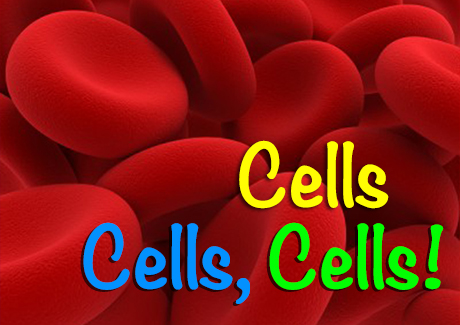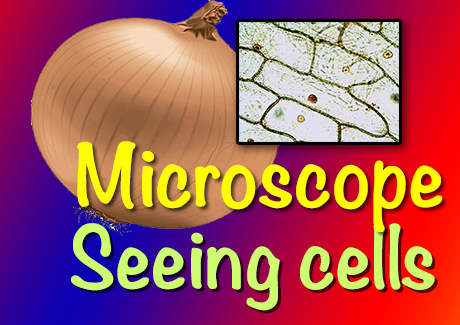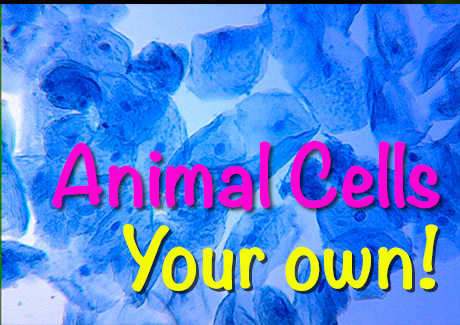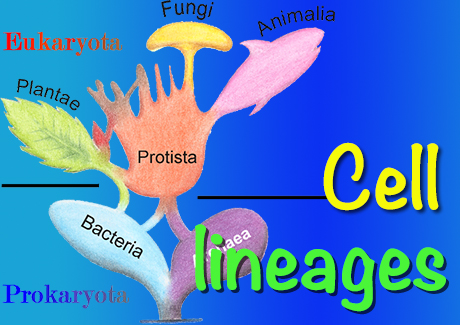


to the image on the next slide.






you will need to use
microscope slides.
Let’s begin with plant cells --
onion cells.




of onion cells.
What do you see?
Not much! The cells are too small to see.
is a thin layer
of cells
pealed from
an onion.



slide labeled
onion cells

of your finger WITHOUT
the aid of the magnifier.
You will need to make the cells appear to be larger than they really are.
You may see more if you rub
your fingertip with a pencil.



the magnifier
to look at your finger.

to examine your
fingerprint.
Observe coins and
other objects
around your home.


to examine
the lettering
on this screen.
at the onion cells on your slide.
What do you see?

the cells enough for you to see them! Your magnifier only
makes objects appear 3 to 5 times larger than they are.

What magnification will you need

you need a light microscope.
Compound microscopes start
at 100x and typically go to 1000x.

a smartphone or
tablet to use
this microscope.
as directed.
the clip-on microscope
and the light attachment.
using a smartphone or a tablet.




1. Use the two metal clips to hold
the microscope slide in place.
2. Center the sample over
over the microscope lens.
3. Turn on the light source.
4. Pinch open the clamp.
5. Gently line up the microscope
lens with the camera lens.
The cells will come into view
WHEN the two lenses are lined up.
6. Now use the clamp to hold
the microscope in place over the camera lens on the device.
follow the directions in the video.

to further enlarge and
enhance the photos
of your slides.
photos of your cells
with the standard
camera app.



The interlocking of many
cells gives strength
and form to the roots,
stems and leaves of a plant.
cells. Do you see a number of individual onion cells?


of one section
in a photo app

sheet of paper.


of a few onion cells
as seen in the photo app.



for making each cell. This information is called “genetic” information.
The genetic information in the nucleus is encrypted in the molecule called -- Deoxyribo Nucleic Acid -- DNA!
inside each onion cell?
This is a NUCLEUS. Label it.
What does the nucleus DO
of onion cells.
is surrounded by a thick surface or wall?
Label this the CELL WALL.
What does the cell wall DO
• protect the cell
• maintain the cell’s shape
• prevent excessive water uptake
• are made up of cellulose


that encircles the cell. It is difficult
to distinguish at this magnification
but label it the PLASMA MEMBRANE.
What does the plasma membrane DO
The CYTOPLASM of onion bulbs is packed with energy stored in the form of sugar. The sugar stored in each cell of the bulb allows the onion plant to survive over the winter without leaves.



The PLASMA MEMBRANE
controls what goes in and out of a cell.
that is OUTSIDE the nucleus.
Label it on your onion cell diagram.
What does the cytoplasm DO

microscope slides.





in and out of the pipette.
out of the bulb.
Lower the pipette tip
into a cup of water.
Suck in water by reducing your
finger pressure on the bulb.
Squeeze the bulb to
release one small drop
at a time onto a penny.
can you put on
the head of a penny?
The record is almost
100 tiny droplets.
Try it.




section of this
THIN layer with
a fingernail or tweezers.
after a sunburn.
begin by slicing
your onion into halves
and then quarters.
a single
segment of onion.
Snap the onion segment back
toward the outer smooth side.
Notice that there is a THIN layer
of cells on the inside of each piece.
the THIN onion layer
onto the center
of the slide.
piece to fold up into a wad.
It should be flat and smooth.







take a few minutes for the stain to be absorbed
into the cells.
Use a small piece of paper to blot up any excess liquid.
of the coverslip
over the layer of onion,
as shown.
of iodine OR food coloring stain
onto the onion tissue.


the one used in the pre-made slide.
Do your iodine stained cells look different than the blue stained cells?

a blue stain that attaches
to negatively charged particles.
This stain tends to attach
to the DNA in the nucleus,
turning it an intense blue color.
You may also see the nucleolus,
a dark spot in the nucleus.
Do you see the differences?
Go back and look.
In your science classes, you will use different stains to hi-light different regions within a cell.






outer layer made of cellulose. Name it.
inside a plant cell that stores most of the DNA.
blocks of life called
OUTSIDE the nucleus
but inside the cell called






(DeoxyriboNucleicAcid)













